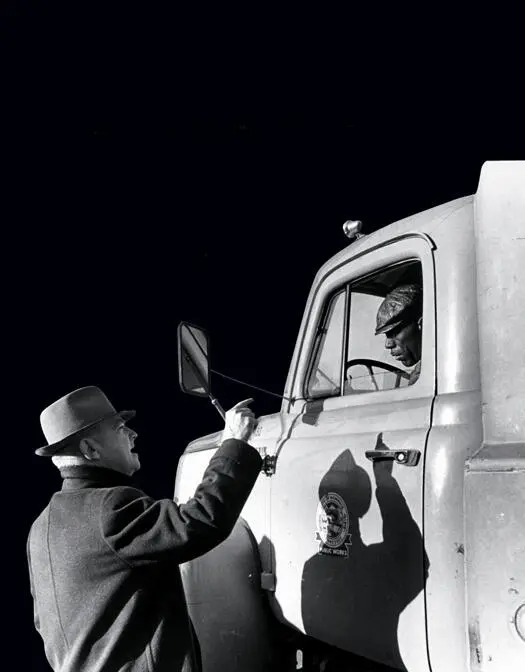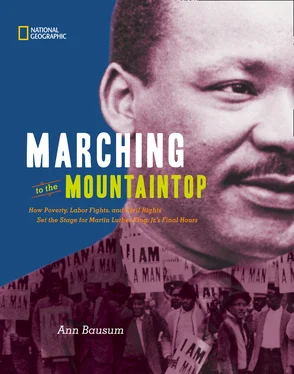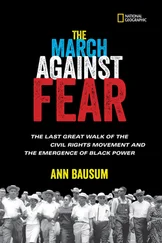On February 24, 1968, local clergy establish a strike-support organization called Community on the Move for Equality, or COME.

James Lawson, an associate of King’s with deep experience in the use of nonviolence and a local Methodist minister, becomes the group’s leader.
Other key organizing ministers include Presbyterian Ezekiel Bell, Clayborn Temple’s white leader Malcom Blackburn, Baptist minister and local judge Benjamin Hooks, AME leader H. Ralph Jackson, Baptist minister James Jordan, Baptist minister Samuel “Billy” Kyles, Baptist minister and youth organizer Harold Middlebrook, and AME minister Henry Starks(president of the association of local African-American ministers).
Charles Cabbage(left) and Coby Smith(right), who had founded the Black Organizing Project (BOP) in 1967, question the exclusive use of nonviolence as a force for change; they maintain an uneasy alliance with COME, especially after setting up a militant offshoot to BOP known as the Invaders with associates such as Calvin Taylor.
Other notable strike supporters include local activist Cornelia Crenshaw, Dick Moon(the university chaplain who mounts a hunger strike in April 1968), Maxine Smith(executive director of the local chapter of the NAACP), NAACP president Jesse Turner, and white Methodist minister Frank McRae(who tries to persuade the Memphis mayor to settle the strike).
Public workers organize the American Federation of State, County and Municipal Employees, or AFSCME, during the 1930s. By 1968 the organization represents almost 400,000 members in nearly 2,000 local chapters, including Memphis Local 1733.
T. O. Jones, president of AFSCME Local 1733, who helped found the fledgling union in 1963, stands in the front lines throughout the 1968 strike.

Jerry Wurf, international president of the union since 1964, assumes personal responsibility as the advocate for members of Local 1733.
AFSCME field services director P. J. Ciampaserves as the union’s chief liaison with the striking workers.
Other key national players from AFSCME include union organizer Jesse Epps(above), Bill Lucy(the highest ranking African American at AFSCME in 1968), and Joe Paisley(the Tennessee representative for AFSCME).
Workers such as Robert Beasley, Clinton Burrows, Ed Gillis, J. L. McClain, James Robinson, Taylor Rogers, Joe Warren, and Haley Williamsare among the 1,300 menwho fight for recognition as human beings and as members of a union; the vast majority are sanitation workers (1,100), but another 230 hold jobs in the sewer and drainage division of the department of public works.
Other local labor supporters include members of the United Rubber Workers Union (Local 186), Taylor Blair(a white union agent who advocates settlement), Tommy Powell(president of the Memphis Labor Council and a local white), and Bill Ross(a white who leads the local council of AFL-CIO affiliates).

Henry Loeb, mayor of Memphis, 1968-1972, former local business owner, former public works commissioner (1956-1960), and former mayor (1960-1963).
Memphis City Council, thirteen members elected for service beginning January 1968 to fill seven district seats and six at-large seats, including twelve men (three of whom are African American) and one woman.
Charles Blackburn, director of the Memphis department of public works, which employs sanitation and street workers.
James Reynolds, U.S. Department of Labor undersecretary (wearing glasses, back to camera, seated with, counterclockwise, AFSCME representatives Bill Lucy, Jerry Wurf, and P. J. Ciampa).
Frank Miles(far left), Memphis labor advocate and local businessperson.

Chapter 1
DEATH
IN MEMPHIS
“It was horrible,” said the woman.
One minute she could see a sanitation worker struggling to climb out of the refuse barrel of a city garbage truck. The next minute mechanical forces pulled him back into the cavernous opening. It looked to her as though the man’s raincoat had snagged on the vehicle, foiling his escape attempt. “His body went in first and his legs were hanging out,” said the eyewitness, who had been sitting at her kitchen table in Memphis, Tennessee, when the truck paused in front of her home. Next, she watched the man’s legs vanish as the motion of the truck’s compacting unit swept the worker toward his death. “The big thing just swallowed him,” she reported.
“We shall overcome. We shall overcome.
We shall overcome some day-ay-ay-ay-ay.
Deep in my heart, I do believe,
We shall overcome some day.”
Freedom song adapted from a gospel hymn for a southern labor fight during the 1940s
In 1968 many Memphis residents stored their trash in uncovered 50-gallon drums. Frequent rains added to the soupy, unsavory nature of the garbage that workers transferred to waiting trucks. The exclusively African-American workforce took its orders from white supervisors (above).
U nbeknownst to Mrs. C. E. Hinson, another man was already trapped inside the vibrating truck body. Before vehicle driver Willie Crain could react, Echol Cole, age 36, and Robert Walker, age 30, would be crushed to death. Nobody ever identified which one came close to escaping.
Cole and Walker wore raincoats for good reason on February 1, 1968. At the end of a wet workday, Willie Crain’s four-man crew had divvied up the truck’s available shelter for the trip to the garbage dump. Elester Gregory and Eddie Ross, Jr., squeezed into the driver’s cab with Crain and left the younger members of the crew with two choices. They could hold on tight to exterior perches while the truck passed through torrential rains. Or they could climb inside the truck’s garbage barrel, wedged between the front wall of the vessel and the packing arm that pressed a load of refuse against the rear of the truck. Walker and Cole opted for the dryer and seemingly more secure interior space.
Читать дальше















